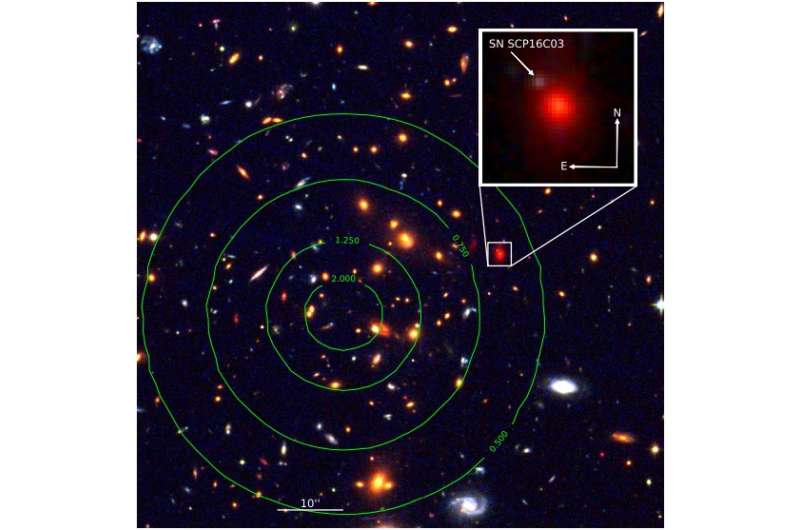July 24, 2017 report
New Type Ia supernova discovered using gravitational lensing

(Phys.org)—Using gravitational lensing, an international team of astronomers has detected a new Type Ia supernova. The newly discovered lensed supernova was found behind the galaxy cluster known as MOO J1014+0038. The findings were detailed in a paper published July 14 on the arXiv pre-print repository.
Gravitational lensing occurs when a large mass bends the path of background light. The method is mainly used to detect objects regardless of the light they emit. Massive galaxy clusters often serve as gravitational lenses enhancing the apparent brightness of distant objects. They offer an amplified and magnified view of the high-redshift universe.
Recently, a team of researchers led by David Rubin of the Space Telescope Science Institute in Baltimore, Maryland, have used one such massive galaxy cluster to reveal the presence of a new type Ia supernova. This type of supernovae can be found in binary systems in which one of the stars is a white dwarf. Type Ia supernovae are important for the scientific community as they offer essential clues into evolution of stars and galaxies.
Rubin's team monitored 12 massive galaxy clusters with the Wide Field Camera 3 (WFC3) on the Hubble Space Telescope (HST) as part of the Supernova Cosmology Project "See Change" program. These observations were complemented by an analysis of images available in the Massive and Distant Clusters of WISE Survey.
The researchers found a promising supernova candidate at a redshift of 2.22 behind the galaxy cluster MOO J1014+0038. Follow-up photometric and spectroscopic observations conducted using HST and the X-shooter multi-wavelength medium-resolution spectrograph on the Very Large Telescope (VLT) in Chile confirmed that the newly found object is a type Ia supernova.
"We present the discovery and measurements of a gravitationally lensed supernova (SN) behind the galaxy cluster MOO J1014+0038. Based on multi-band Hubble Space Telescope and Very Large Telescope photometry and spectroscopy, we find a 99 percent probability that this SN is a SN Ia, and a 1 percent chance of a core collapse (CC) SN," the scientists wrote in the paper.
According to the paper, the newly detected supernova, designated SN SCP16C03, is the highest redshift Type Ia supernova with a spectroscopic redshift and the highest redshift lensed supernova of any type. So far, the redshifts of gravitationally lensed background Type Ia supernovae have been lower than 1.39.
Moreover, SN SCP16C03 is also the most amplified Type Ia supernova discovered behind a galaxy cluster to date.
"We estimate an amplification of 2.8 (1.10±0.23 mag)—compatible with the value estimated from the weak-lensing-derived mass and the mass-concentration relation from ΛCDM simulations—making it the most amplified SN Ia discovered behind a galaxy cluster," the paper reads.
More information: The Discovery of a Gravitationally Lensed Supernova Ia at Redshift 2.22, arXiv:1707.04606 [astro-ph.GA] arxiv.org/abs/1707.04606
Abstract
We present the discovery and measurements of a gravitationally lensed supernova (SN) behind the galaxy cluster MOO J1014+0038. Based on multi-band Hubble Space Telescope and Very Large Telescope (VLT) photometry and spectroscopy, we find a 99% probability that this SN is a SN Ia, and a 1% chance of a CC SN. Our typing algorithm combines the shape and color of the light curve with the expected rates of each SN type in the host galaxy. With a redshift of 2.2216, this is the highest redshift SN Ia discovered with a spectroscopic host-galaxy redshift. A further distinguishing feature is that the lensing cluster, at redshift 1.23, is the most distant to date to have an amplified SN. The SN lies in the middle of the color and light-curve shape distributions found at lower redshift, disfavoring strong evolution to z = 2.22. We estimate an amplification of 2.8+0.6-0.5 (1.10+-0.23 mag)—-compatible with the value estimated from the weak-lensing-derived mass and the mass-concentration relation from LambdaCDM simulations—-making it the most amplified SN Ia discovered behind a galaxy cluster.
© 2017 Phys.org





















